PEX with too many fittings?
New house is being built for me. I specified PEX with a manifold system. I was expecting PEX runs to minimize on fittings and to be bent around corners wherever possible to ease installation, reduce pressure drop due to turbulence in the flow, lessen probability of leaks, reduce labor, and minimize fittings cost. Attached photos shows the subcontractor's manifold installation. We have high (80 PSI) incoming pressure, so I think that we are fine even if there is some drop in the lines when water is flowing. Assuming the feed to the manifold is adequate, I don't anticipate much undesired interaction between the various end uses. Yet, the appearance of the installation, and all the work it involved puzzles me. Any thoughts would be appreciated.
Comments (41)
geoffrey_b
10 years agoWow, unbelievalbe! I've seen submarines with less complex piping. But I'm just an engineer, not a plumber.
Looks neat, but a huge can of worms. Are any of those runs marked? Looks like a huge maintenance nightmare.
I would make several 'home runs' with larger tubing, to feed smaller manifolds - which supply 2 / 3 rooms each. This will elimate lots of fittings and piping.
The amount of fittings looks ridiculous.
I'd get another master plumbers opinion. Don't let them close this sucker up!
Related Professionals
Miller Place Plumbers · Chantilly Handyman · Auburn Kitchen & Bathroom Remodelers · Cocoa Beach Kitchen & Bathroom Remodelers · Eureka Kitchen & Bathroom Remodelers · Ewa Beach Kitchen & Bathroom Remodelers · Idaho Falls Kitchen & Bathroom Remodelers · Martha Lake Kitchen & Bathroom Remodelers · Port Charlotte Kitchen & Bathroom Remodelers · Pueblo Kitchen & Bathroom Remodelers · Republic Kitchen & Bathroom Remodelers · Saint Helens Kitchen & Bathroom Remodelers · Lawndale Kitchen & Bathroom Remodelers · Eufaula Kitchen & Bathroom Remodelers · Hewitt Kitchen & Bath Fixturesjackfre
10 years agolast modified: 9 years agoThey make supports for pex that snap on the pipe and create a sweep. You then get the much reduced pressure drop you want. Remember every one of those 1/2" fittings is probably 5/16 th inside diameter. You have a lot of bushing affect here. I'll be interested in how this works out for you pressure wise. You are lucky to have 80# to start with. I'd certainly do faucet and shower tests prior to letting the sheet rock go in.
homebound
10 years agolast modified: 9 years agoNot my area of expertise, but is that really PEX or is it CPVC? What does it say on the pipe?
jakethewonderdog
10 years agolast modified: 9 years agoOkay, keep in mind that the real question here isn't the total number of fittings, it's the number of fittings per run.
There's nothing to suggest that the number of fittings per run is excessive or going to cause significant pressure drop.
What people are reacting to is the shear number of runs.
Although what was done is acceptable and common practice, I agree with Geoffrey_B, a hybrid system with branches and then manifolds at several locations is more the way I would approach a larger house.
geoffrey_b
10 years ago@jake: I can just imagine, none of those pipes are marked. You have a leak? WTF?
Then, can you imangine taking any of those runs apart? I mean there's no clearance for reparing an inside run.
The guy who did that is ADHD.
jakethewonderdog
10 years agolast modified: 9 years agoThere is nothing wrong with the work that was done here - there's just a lot of it.
If there are plumbing code violations, I'm waiting to hear what they are.
The work was neat, orderly, and I see no faults with it. Someone with sharper eyes might have a differing take on it.
Having a lot of runs isn't a code violation - it's not even a bad practice. I haven't seen runs labeled in a residential installation or even most light commercial work. I could see doing the hot and cold in different color of PEX is all.
I don't think it's fair to trash the guy's work at all.
If it were to leak you would repair it the same way you would repair any PEX run. Hell, you could replace an entire section of tubing between fittings.
Again, what people are reacting to is the 25 lines going into a single manifold.
DreamingoftheUP
10 years agolast modified: 9 years agoIt has an awesome symmetry to it. Reminds me of, hmmm - was it Henry Ford? - where he specified central control in the basement with valves for every fixture in the large mansion.
geoffrey_b
10 years ago@jake: "There is nothing wrong with the work that was done here - there's just a lot of it. "
As an engineer, the problem with a lot of trades people is that they are doer's. They don't think alot about the future. Just get it done and move on.
Think about that mess, in 25 years. There's a problem, a leak, wanting to add a new circuit.
What - you don't label 25 runs? I guess it's because you know what they are today. A year from now, you won't remember. But hey, who cares, your just getting paid for completing the job today. Screw anyone in the future.
Your statements are why I advise to trust NO trades people. That PEX hack job is the best example of how not to implement a design. It violates no codes - except the code of common sense!
My advice is to give trades people very tight/specific specs and have their work inspected, before the inspector.
greg_2010
10 years agolast modified: 9 years agoHow do you know that he isn't going to label the runs?
jakethewonderdog
10 years agolast modified: 9 years agoThe shut-offs will be marked - that's a given.
But unless someone sees something I don't, there are no code violations, no violation of standard practices or even a violation of good workmanship.That's what the homeowner needs to know.
Geoffrey, what I know from my current professional life as the director of an IT department is that you deal with quantifiable standards.You don't use comments like "hack job" and saying the person has a mental illness when, in fact, you admit that you aren't experienced in the area in question and you are using your own standards that you are pulling out of your ass. Your comments are grossly unprofessional - one engineer to another.
Before overseeing computer networks, my history is as the head of maintenance for several hi-rise and mid-rise buildings. I'm very familiar with maintaining systems 25 years after they've been installed.
I've also renovated and restored about a dozen older homes from the 1890-1920's. Again, I'm familiar with repairing and replacing older systems.
There's nothing about this workmanship that would prevent someone from maintaining it in the future. Any additions would be home run to the manifold. Any repairs would be spliced using appropriate methods.
geoffrey_b
10 years ago@greg: "How do you know that he isn't going to label the runs?"
Well if he didn't when he started it will take him even more time to back and trace the runs
geoffrey_b
10 years ago@jake:" The shut-offs will be marked - that's a given."
This guy is going to have 25-30 shut-offs??
@jake: "what I know from my current professional life as the director of an IT department is that you deal with quantifiable standards"
Well I have degrees in engineering and comp sci. Been a software developer for over 40 years - Langley / Raytheon / DoD / large commercial apps.
That pex mess looks like many of the awful software systems that I've seen people cobble together. We rip them out and replace with simpler, less breakable, software.
@jake: "You don't use comments like "hack job" and saying the person has a mental illness when, in fact, you admit that you aren't experienced in the area in question ."
Having worked with planes, subs, orbiter, I'm quite familiar with how cables / tubing / connections are laid out. My grandfather had a Mech. Engineering business, and I did quite a lot of HVAC work while in HS and College.
@jake: "and you are using your own standards that you are pulling out of your ass"
I know my own common sense. To be technical there is no standard on how to arrange those runs - just common sense.
All that tubing in the ceiling - how would you close that ceiling up?
A much better way would be to identify the areas that required water - bathrooms and kitchen.
Then locate smaller manifolds near those areas - so you could run a bathroom or two from a manifold. He would use larger tubing to the manifolds. Less smaller diameter tubing and less fittings. You could have shutoff valve for each H/C to a manifold. A much more manageable design.User
10 years agolast modified: 9 years agoGeoffrey - Plumbing in an industrial/commercial setting is always going to be different from plumbing in a residential setting. There are benefits to installing one manifold in a residence rather than several. A residence may only have one utility space where a manifold may be reasonably installed. It may not be possible to have visible manifolds in several locations. One centralized manifold allows the homeowner to go to one location for any water shutoff, rather than one of several different locations.
Is this plumbing design as simple and elegant as it could be? Maybe/maybe not. It is impossible to tell without knowing the layout of the house. Engineers often forget that function for the end user is paramount, and a good engineer wouldn't have the hubris to pronounce a system unacceptable or presume to proclaim a "better" way without the information relevant to design decisions.
geoffrey_b
10 years ago@alice: "and a good engineer wouldn't have the hubris to pronounce a system unacceptable or presume to proclaim a "better" way without the information relevant to design decisions"
WoW - now blame - I'm not a GOOD ENGINEER - I have degrees from Lehigh and Penn State. I've not only learned my trade, but I've worked in it, for more than 40 years.
I know sh*t when I see it. I believe Justice Earl Warren said "I can't define porn - but I know it when I see it."
Sorry, you don't have the self confidence to form your own opinion. Maybe you need an 'expert' whatever that is. But I know crap work when I see it.
You want to give this guy a pass cause it's "residential." That's fine with me. Just not my home.
P.S.: The real problem is that guy 'fanned out' too soon. Look it up.
Circus Peanut
10 years agolast modified: 9 years agoLike the original poster, I don't have any problem with the manifold itself -- like him, I wonder why there are so many 90° metal fittings put on. Isn't the advantage of PEX that it can swoop to save pressure drops? Don't most PEX manifolds in residential houses look more like these below? (Ours does.) What's with all the metal elbows his guy installed?
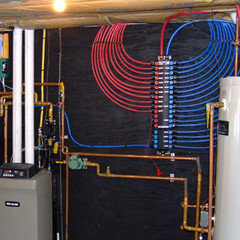
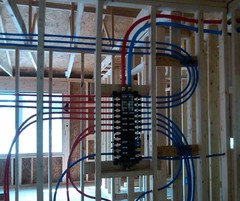
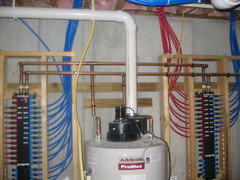
geoffrey_b
10 years agoThis is what happens when you let (unknowingly) a pubic HS grad implement your plumbing system.
I'll bet that the drainage system is much more orderly.
Circus Peanut
10 years agolast modified: 9 years agoG, I see no reason to impugn either the quality of the OP's job or its installer's educational level -- I'm just asking what standard best practice is for this type of manifold install with PEX. Can you address the fittings issue itself?
Ours is a retrofit to new copper manifold with swooped PEX and I see no metal fittings of any kind along the entire PEX run up to our cast-iron radiant heaters, other than a few clamps holding it to the wall or ceiling. Has worked brilliantly so far and we are very pleased; combined with a high-efficiency Viessmann boiler we have more than halved our monthly natural gas bill.
aidan_m
10 years agolast modified: 9 years agoIs the end user not primarily concerned with adequate flow at each fixture and the desired output temperature arriving as quickly as possible?
Why would a centralized manifold location be more important than having warm water quickly and of adequate flow at each point of use? I think the OP is concerned with performance as a function of regular daily use, rather than performing maintenance at some unknown time in the future. The question is: "Are the elbows are going to lower performance?" They will, and the OP is rightfully concerned. A simple but effective test would be to fill a 5 gallon bucket at each point of use, measure the time and determine the flow rate in GPM. High demand fixtures like shower and tub valves have minimum flow requirements for the unobstructed supply pipe, given in GPM. The 5 gallon bucket test is an accurate metric of GPM.
The separate runs to each fixture make for lots of waiting time for warm water over a trunk and branch layout. The bushing effect is going to significantly diminish the flow. This is compounded by the use of multiple elbows at the beginning of long runs. A tub filler or hose bib is not going to have the same rate of flow as it would if sweeping bends were made instead of using the elbows with bushings.
Those are the facts. It is very common for people to think that there is something wrong with their hot water system based on the time it takes for hot water to arrive at various fixtures. This is a symptom of a bad design. It is also exactly how a manifold system is going to perform, because of the way it is designed.
The bottom line is that a manifold system must be designed thoroughly by a mechanical engineer. The design must specify every component, right down to each fitting and location, if the system is going to perform optimally. The installer should not be selecting and assembling the components based on his or her discretion.
geoffrey_b
10 years ago@aidan_m: "The bottom line is that a manifold system must be designed thoroughly by a mechanical engineer. The design must specify every component, right down to each fitting and location, if the system is going to perform optimally. The installer should not be selecting and assembling the components based on his or her discretion. "
Thank you! Better stated than my response.
Totally an assumption, but making all the runs 'home run' runs makes no sense. Better approach would be a trunk (branch) line, and run smaller manifolds off of that.
scibidr
Original Author10 years agolast modified: 9 years agoHere again from the OP: Many thanks all for your thoughtful comments. There is another issue as well with all the fittings. My previous experience with copper has been pinhole leaks, accelerated by corrosive water. In principle, using PEX with no "buried" fittings, we won't have to worry about what is going on behind the walls. In this new construction, with brass buried all over the place, we may be in worse shape than we were with copper. Particularly, I am referring to the process known as "dezincification," whereby even noncorosive water will eat the zinc in the brass alloy. The result is a porous fitting that crumbles under finger pressure. When I specified a PEX manifold system, I was expecting a system similar to those photos posted by "circuspeanut."
jakethewonderdog
10 years agolast modified: 9 years ago@aidan_m: "The bottom line is that a manifold system must be designed thoroughly by a mechanical engineer. The design must specify every component, right down to each fitting and location, if the system is going to perform optimally. The installer should not be selecting and assembling the components based on his or her discretion. "
This is just a lot of nonsense and has never happened - EVER- in residential plumbing. Neither are installers installing whatever they happen to have in their back pocket.
Just as a residential builder doesn't have to engineer each wall and fastener, plumbers have both code and design guidelines that they work with - not to mention experience. Sure, they going to do some calculations when they plan out the plumbing - things they've done a million times -- but a mechanical engineer?!? Specing the materials and location of each fitting?!? It has never happened. You couldn't afford the cost of the home if it did.
Look, other than the two examples of the wide-open hose bib or tub spout, virtually every other tap is intentionally restricted to reduce flow rate (about 1 gpm for bath sinks, 1.5 - 2 gpm for kitchen sinks, 2.5 gpm for showers). If a plumber runs into something unusual - a multi-head shower for example - he's going to do the math... but 95% of his residential work falls into the same design that he's done a zillion times before and there's plenty of headroom in the design for additional el's if he needs them on the job site.
A few fittings is not going to make an appreciable difference in pressure drop and thus flow rate in 1/2" pex serving a single tap -- it's just not. Remember this is going to get dropped down to 3/8 od supply lines, the internal workings of the faucet, and then the flow restrictor at the end.
True, the sweeping turns without fittings makes the job faster, cheaper and less chance for leaks - but those are benefits that accrue mostly to the plumber.
Look, I've seen and heard of terrible plumbing design and workmanship, some of it on this board. The water heater in the garage and long, uninsulated hot water run in a slab to the master bath at the other end of the house comes to mind as the most egregious. This doesn't fit into that category. I have to assume that there was a reason to do this work with fittings that we aren't aware of. BTW: I've seen some terrible design work by architects and educated people who should know better - but are too full of themselves to even question it.
If all of the water taps are in one area, a single manifold system can be fine. If they are all over the house, a hybrid branch and manifold system can work better. It should all be designed for short hot water runs. The trade-off with a branch system is that the large pipe sizes at the base of the branch can cause very long wait times for hot water - esp the first use.
This post was edited by jakethewonderdog on Fri, Mar 14, 14 at 11:24
jakethewonderdog
10 years agolast modified: 9 years agoOP -
Here's the thing: You need to talk to your plumber - preferably have a sit-down with the installer and the owner of the company.
What you should probably know is that being combative based on pressure drop isn't going to go very far - it's pretty much a non-issue. Be diplomatic - calling it a hack job isn't going to work well for you. That said, it's your house and it will make you angry as long as you are there so you might as well get it the way you want it.
Show him the photos of what you were expecting. Tell him you are concerned about the potential for leaks and such.
Your plumber is going to be out an amount of money for re-work. That happens sometimes... the larger the outfit, the more they can afford to eat a loss on a job. Perhaps even compromise a little and offer to pay for the PEX to redo it (the pex is cheap, the labor is expensive). If you do that, be sure you get that cost in writing up front.
jakethewonderdog
10 years agolast modified: 9 years ago@Geoffrey - This guy is going to have 25-30 shut-offs??
Yes, you pompous ass with absolutely no plumbing experience - each of those round knobby things on the manifold are shutoffs. They will be labeled as required by code. Enough said.
geoffrey_b
10 years ago@jake: Looks like aidan_m handed you your ass.
You really like to make excuses for shoddy work by claiming it's residential.
Gonna take you a while to walk back all that misinformation you doled out.
@jake: "They will be labeled as required by code. Enough said."
How can you say this?
@jake: "Perhaps even compromise a little and offer to pay for the PEX to redo it (the pex is cheap, the labor is expensive). "
I wouldn't talk to him. I would fire the guy by certified letter. Give him a second chance? Why? After seeing the crap job he did the first time.
greg_2010
10 years agolast modified: 9 years agoGonna take you a while to walk back all that misinformation you doled out.
Can you please point out where jake put out misinformation? I've read over the thread and honestly don't see it. There are definitely differences of opinion, where he's saying that it might not be a problem and you are saying that there definitely is a problem.
He even agreed with you that a hybrid system with branches and then manifolds at several locations is more the way I would approach a larger house.We have no idea what size this house is. Maybe it isn't that big and this manifold system will work just fine. Maybe not. But again ... we only have a single photograph.
And why are you so sure that there will be no labeling? This obviously isn't a finished job. Maybe the installer has made notes and plans on making neat labels once it's finished?
I honestly think you are making a lot of assumptions based on a single photograph. And getting really angry about it, too.
Or maybe I'm mistaken and you've actually visited this site and have more information than the rest of us. If that's the case, I'll step back and concede to your more informed judgement.
The only puzzling part in my mind (and the OPs) is why he used all of those corner fittings instead of sweeping arcs like the other photos posted in this thread. He might have a good reason ... or he might not. It might be problem ... or it might not. The only way to know is to open a dialog with him. Not just sending a certified letter firing him and ripping everything out.
You seem to live in a very black and white world. There's your way or the wrong way and there's no questioning it.
greg_2010
10 years agolast modified: 9 years agoAnd to the OP:
My previous experience with copper has been pinhole leaks, accelerated by corrosive water.Does this new house have the same type of water as your old one? Have you had it tested?
Edited: Re-read your post and I see that you're concerned about dezincification, not corrosive water. I have no knowledge of that, so I don't know if it's a legitimate concern. So you can ignore this post. :)
This post was edited by greg_2010 on Fri, Mar 14, 14 at 15:04
jakethewonderdog
10 years agolast modified: 9 years agoGeoffery, Adrian did nothing of the sort. Please use your boundless engineering prowess and do the math for us.
Here's what we know:
Static head pressure is 80 psi
1/2" pexHere are the assumptions I used:
30' run
restricted to 2 gpm at the point of use
70 degrees F6 - 90 degree elbows ( I only counted 3 per run... but we will double that for grins and giggles) would introduce less than the equivalent of 1 psi drop in additional friction losses - this on a system where the pressure is already at the high end of what's allowable.
Yes, those are shutoffs on the manifold - they are allowed in lieu of fixture stops and they will be labeled. Pretty sure labeling them is required by code.
Re: Fire the contractor by certified letter: You are just full of bad advice for the OP. The contractor likely has a mechanic's lien on the project and the bank is going to want the liens released before final financing.
The OP is FAR better off trying to negotiate a settlement than to unilaterally terminate the contract. Even if the OP does need to ultimately terminate the contract, having made a good faith effort to resolve the problem will work in his favor.
jakethewonderdog
10 years agolast modified: 9 years agoOP:
I appreciate that what you got was not what you were expecting to get. Know that there is usually a certain amount of brass / copper in a pex system including the manifold itself and the fixture stubs. Also, there can be in the feeds to the manifold, etc.
Alice is correct, what was installed was "inelegant" - but that puts you in a tricky place because unless someone can point out something specific (contrary to code, good workmanship, manufacturers instructions, etc.) you aren't going to prevail on technical grounds.
I calculated that 6 - 90 degree elbows per run would introduce a total of less than 1 psi additional friction loss (except on a tub spout or hose - where they are unrestricted and the loss would be slightly greater)
Be sure to review all of your communications about the plumbing specs: Look for anything that shows you intended the installation to minimize metal fittings.
I don't know how you are doing this house - if you are acting as the GC or if you are working with a GC. You should sit down with your GC though and show him what your concerns are and what you thought you were going to get. We all know that sh-t happens on a job... if you have been pretty reasonable with your GC up to this point it will be easier to ask him to eat at least part of the re-work. If you've already made him eat a lot of losses, he's going to fight you on this one.
aidan_m
10 years agolast modified: 9 years agoFrom the PEX design guide on manifold systems:
"Tubing shall be run continuously and as directly as possible between manifold and fixture locations. Approved fittings may be used to repair kinked or damaged PEX distribution lines, or to add to a distribution line that was mistakenly cut too short during installation. Excessive use of fittings is unnecessary."
It is obvious from looking at the pictures that all the runs are using the same small diameter tubing and excessive number of fittings. This one size fits all approach will result in underperformance at the hose bib and bathtub locations. The design was implemented by the plumber who meticulously assembled the components he selected. It is evident that calculations were not performed, or there would be evidence of larger capacity runs of tubing for the fixtures that demand it.
A 100 foot run of 3/8" nominal diameter PEX tubing would require a velocity of over 12 feet per second in order to supply 4 GPM. Hose bibs usually supply at least 4 GPM. The pressure drop will be nearly 80 psi. The tables published do not go up to that high for the 3/8" tubing, you have to go up to the next size.
Here is a link that might be useful: PEX design guide
jakethewonderdog
10 years agolast modified: 9 years agoOkay Aidan,
We both know they didn't use 3/8" in this installation - and that you wouldn't use 3/8" pex for a high flow fixture such as a tub or hose- it's only suitable for a sink faucet at 1 - 1.5 gpm.
In practice, you just don't see 3/8" used very often - for the very reasons you mention. With 3/8" you really do have to pay close attention to the design. You certainly wouldn't do a 100' run with it either.
The only reason to use 3/8" pex is to reduce the wait time to get hot water to a fixture such as a sink.
geoffrey_b
10 years agoFrom the PEX design guide on manifold systems:
"Tubing shall be run continuously and as directly as possible between manifold and fixture locations. Approved fittings may be used to repair kinked or damaged PEX distribution lines, or to add to a distribution line that was mistakenly cut too short during installation. Excessive use of fittings is unnecessary."
Let's use some deductive reasoning: Looking at the OP's layout, it's obvious that the plumber spent a lot of time measuring, and cutting the PEX, as well as attaching all the fittings. Much more time and fittings than is necessary. The guy doesn't get it, and asking him to do it over will end in frustration.
To this plumber, PEX is just another pipe, not a well thought out system. Could be copper, steel, PVC, or PEX - cut it up and install fittings!
jakethewonderdog
10 years agolast modified: 9 years agoGeoffery, you could be right about that - I wondered myself if the installer did that throughout. It wasn't uncommon when installers in US first started installing it.
My initial assumption was that the installer needed to install in a tight space and thus make the sharp 90's. If that was the case, what he did was fine. As I've said, even 6 extra elbows isn't going to cause a problem.
If he's installed elbows everywhere, could still be acceptable from a functional standpoint - but would be an indicator that the plumber isn't well versed in installing PEX... which doesn't instill much confidence.
I stand behind the advice to the OP: Even if they've used elbows throughout, it will be tricky to get it re-worked without eating the cost of it. Even so, it's worth doing because the OP is going to be angry about it even if it's up to code and completely functional.
scibidr
Original Author10 years agolast modified: 9 years agoMore from the OP: Interesting to me that the post would stimulate this much discussion. By way of more info, the PEX and many more fittings than those in the photo, were long ago enclosed behind drywall. I made the decision to accept it considering battles I should fight vs. leave alone. The one-piece manifold itself was a result of my insistence. Plumber originally made his own manifold with 3/4" PEX and large number of full-port ball valves (see photos). Needless to say, there was a large amount of labor involved. The two dozen or so small sections of PEX and ~50 fittings connecting them were all in series, and in the main line feeding all of the "manifold" branches -- lots of turbulence in the flow. In this case, for sure, we would have been victim to the pressure drop problem causing interactions between the various branches.
By accepting a hundred or more fittings behind the drywall, I realize that some day I will likely confront an inaccessible leak and all that implies. (Just work with the result of many small probabilities acting together.) Even fitting-less PEX can leak if there is movement and abrasion, or if rodents chew it. However, my general contractor is extremely conscientious and straight. We like him a lot. Unfortunately, he and the plumber just don't know how much they don't know. My contractor has been very kind in correcting and eating the cost of other major mistakes. These mistakes have been more obvious to them, so the corrections have been easier to sell.
My background is that of an engineering physicist and university professor, also with 33 years industrial experience doing practical things. I have fair amount of hands-on experience in electrical and mechanical matters, though my principal focus has been optics, electronics and computational image processing. I come from a long line of mechanical engineers and have many dozens of books on my shelf from the careers of my forbears and wife, who is also a mechanical engineer. There is much I don't know about construction codes, and the realities faced in the trades. I do respect their art. Yet, you can see the issues that arise when they have to deal with people like me. I try to be gentle, keep an open mind, and realize that there are things I can still learn from them.
The house we are building has 3300 ft^2 of living space. I designed it so the kitchen, laundry, and three bathrooms are more-or-less stacked so as to minimize plumbing runs. That is one reason I am not too concerned with pressure drops in the branches. Another is the mandatory use of pressure-balance controls in the bath and shower.
Pressure drop to the hose bibs is not an issue, except for one consideration. Hose bibs will all be fed by a separate well-water system and 3/4" PEX. I wish I could lay my hands on a full-port frost free hose bib, but they don't seem to exist. I can see why, given the design challenge they would pose, and potential cost. Probably won't matter much.
Thanks again for all your interesting posts.
jakethewonderdog
10 years agolast modified: 9 years agoYeah, sorry it got ugly, but I'm glad to see the discussion. Forced me to go look things up.
It's entirely possible to make a manifold out of COPPER and full flow valves, but this isn't it at all. I can't imagine the reason for all the small pieces of PEX. I've seen some horizontal manifolds built so they both pointed up - eliminating one of the bends in the branches.
Had I seen this in the first place, I would have taken a position closer to Geoffery's but without the pompous attitude. I would have stopped the project right then and insisted on different plumber with the GC. Having half a dozen elbows per run isn't terrible, but that photo makes it clear the plumber doesn't grasp the concept.
New materials and methods can be tough to learn - but if he's going to be a plumber, he needs to go back to school and learn to use PEX. Ten years or more ago you would have seen all of the fittings... but it's not new anymore in the US. He needs to get with the program. Unfortunately the only way he will "get it" is when he's put off a job.
Question: How did any of it get closed up behind drywall when the rough-in wasn't complete? In my area, the inspector wouldn't have signed off on the rough-in inspection -- allowing you to put up drywall -- unless the lines feeding the manifold were in place.
geoffrey_b
10 years ago@jake: "would have taken a position closer to Geoffery's but without the pompous attitude."
Pompous attitude??? Hey I'm from Philly!
Seriously, that second pic, the homemade 'rats nest' of a manifold - looks third world.
User
10 years agolast modified: 9 years agoscribidr - If your water is corrosive, you may be able to take some steps to mitigate dezincification of brass fittings. The good news for you is that the conditions that cause pinhole leaks in copper are not necessarily the ones that cause problems with brass.
Is the new house on city or well water?
Is the water in the new house the same as that in your house that has the leaks?
If you have analysis of your water, I would be happy to take a look at it so see what may be done to extend the life of your plumbing fittings.jakethewonderdog
10 years agolast modified: 9 years agoscribidr - Alice is one of a couple resident water chemistry experts. Take advantage of the offer.
scibidr
Original Author10 years agolast modified: 9 years agoAlice, I appreciate the offer. It may take a few days, but I can get an analysis from the supplier, Artesian Water in Delaware. I understand that the chloride ion is of particular importance with respect to dezincification, which is unfortunate because the new house is on municipal water, not well water. We will have a well, but by law it cannot be hooked up to the potable water system in our house. I also understand that there are dezincification resistant brass alloys and will try to find out what the plumber used.
aidan_m
10 years agolast modified: 9 years agoI just did some testing of the performance of my plumbing supply. This is copper, 3/4" trunk w/1/2" branch to each fixture except the hose bibs which carry the 3/4" cold all the way. They are at the end of the run, which is about 50 to 60' The water supply pressure is regulated by a watts valve and is set at 58 psi.
I tested the flow at the rear spigot and measured 11.1 gpm, or 27 seconds to fill a 5 gallon bucket.
Then I tested the hot water supply capacity of my Bosch Aquaster tankless water heater. I used the garage utility sink because it is closest. This sink is supplied by a 1/2" copper branch off the main 3/4" hot supply, the first tee in the line. The "lousy" Bosch Aquastar put out 4 gpm at a 70 degree temperature rise.
Those results are what someone with good copper piping is used to having. The PEX system is not going to have nearly the same performance at the top end of demand. I agree that the runs from the manifold to most fixtures will be adequate. But if I were the OP, I would insist on separate 3/4" PEX runs to the peak demand fixtures.
jakethewonderdog
10 years agolast modified: 9 years agoYou haven't been paying attention:
He has a 3/4" pex to his hose bibs.
He's not concerned about his tubs because he has mandatory pressure balance valves on them.
What's more, the drywall is up.He's still going to get 4 gpm out of his tub spout - esp if he's mixing from two 1/2" pex lines. I don't know, in practice, if I've ever seen 3/4" pex feeding a tub.
3/4" supply line on a single hot water faucet actually slows down the amount of time to get hot water because there's so much more water in the pipe that has to be flushed to get the hot water out. (I made that mistake myself on my kitchen run).
Most sillcocks are 1/2" - so it gets knocked down to 1/2" at least for the last 8-12". That said, depending on the length of the run, It can make sense to do that in 3/4" up to the sillcock.
















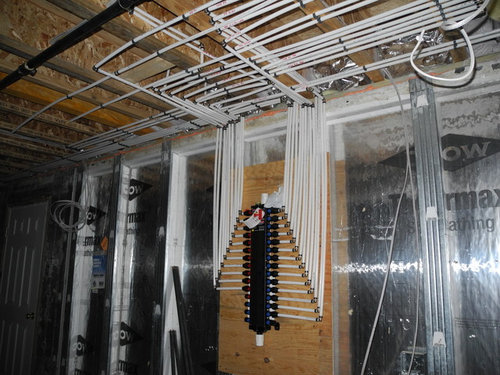

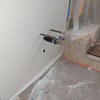
jakethewonderdog